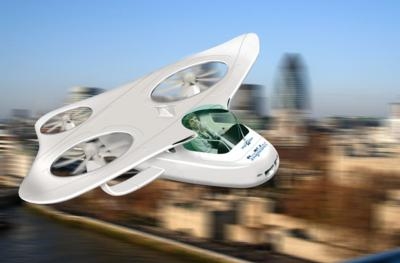Wed, Dec 10, 2014
EU-Funded Researchers Are Behind A New Helicopter Steering Mechanism That Could Open The Door To 'Flying Cars'
European Union-funded researchers with the MYCOPTER project say they have developed a steering system that makes helicopters as easy to control as cars. While having your own personal aerial vehicle (PAV) may still be some way off, the success of the project opens up the possibility that one day flying vehicles could indeed be an integral part of the urban transportation network.

Currently, only pilots who have undergone extensive training can fly a helicopter. Four control axes must be operated in order to maintain a stable position in the air. This requires skill, knowledge and concentration. In order to extend aerial flying to the general public, PAV operation needs to be significantly simplified, with a greater degree of automation introduced.
The MYCOPTER project started in 2011 with the objective of developing a PAV ideally designed for travelling between the home and the workplace. The project envisioned that the vehicle would fly at a low altitude in urban environments, be fully or partially autonomous without requiring ground-based air traffic control and would operate outside controlled airspace. Current air traffic would therefore remain unchanged, ensuring that PAVs could be easily be integrated into the next generation of controlled airspace.
To achieve this, the project replaced the helicopter’s cyclic stick, which is responsible for movements around the longitudinal and transverse axis, with a steering wheel. Pilots simply need to turn the wheel in the intended direction. The MYCOPTER team believes that this represents an important step in making PAVs more accessible to the general public.
Test models were implemented on unmanned aerial vehicles, motion simulators, and a manned helicopter. The project also focused on collision avoidance systems, pilot training and overall streamlining of helicopter control processes. New automation technologies for obstacle avoidance, path planning and formation flying were developed and successfully tested. The MYCOPTER project sought to assess how the benefits of automation could be implemented while still providing the pilot with the ability to feel in control.

The success of the MYCOPTER project suggests that the eventual implementation of a Personal Aerial Transportation System (PATS) could be feasible. Such a system would have a beneficial impact on citizens’ daily lives by helping to resolve issues related to traffic congestion and even environmental pollution.
For example, an aerial transportation network would enable commuters to avoid sitting in traffic queues and instead travel directly between two points. Travelling directly point to point could also save on fuel and help to reduce the stop and go traffic that wastes large amounts of energy.
Outside of this particular project, new battery operated aerial vehicles are currently being developed which could provide further environmental improvements. Less road congestion might also lead to cost savings in terms of road maintenance and associated support structures.
The results of the project, due for completion at the end of 2014, were recently demonstrated and discussed at the German Aerospace Centre (DLR) in Braunschweig, Germany on November 20, 2014.
(Images provided by MYCOPTER. Artist's concepts of vehicle's cockpit, PAV)
More News
Omnidirectional Approach Lighting System ODALS consists of seven omnidirectional flashing lights located in the approach area of a nonprecision runway. Five lights are located on t>[...]
"Polaris Dawn, the first of the program’s three human spaceflight missions, is targeted to launch to orbit no earlier than summer 2024. During the five-day mission, the crew >[...]
Also: 1800th E-Jet, Uncle Sam Sues For Landing Gear, Embraer Ag Plane, Textron Parts A friend of the family reported that Lt. Col. (Ret.) Richard Glenn Rutan flew west on Friday, M>[...]
Also: Virgin Galactic, B-29 Doc to Allentown, Erickson Fire-Fighters Bought, FAA Reauthorization After dealing with a big letdown after the unexpected decision by Skyreach to disco>[...]
“Our aircrews are trained and capable of rapidly shifting from operational missions to humanitarian roles. We planned to demonstrate how we, and our BORSTAR partners, respond>[...]
 ANN's Daily Aero-Term (05.05.24): Omnidirectional Approach Lighting System
ANN's Daily Aero-Term (05.05.24): Omnidirectional Approach Lighting System Aero-News: Quote of the Day (05.05.24)
Aero-News: Quote of the Day (05.05.24) Airborne 05.06.24: Gone West-Dick Rutan, ICON BK Update, SpaceX EVA Suit
Airborne 05.06.24: Gone West-Dick Rutan, ICON BK Update, SpaceX EVA Suit Airborne 05.03.24: Advanced Powerplant Solutions, PRA Runway Woes, Drone Racing
Airborne 05.03.24: Advanced Powerplant Solutions, PRA Runway Woes, Drone Racing Aero-News: Quote of the Day (05.06xx.24)
Aero-News: Quote of the Day (05.06xx.24)




